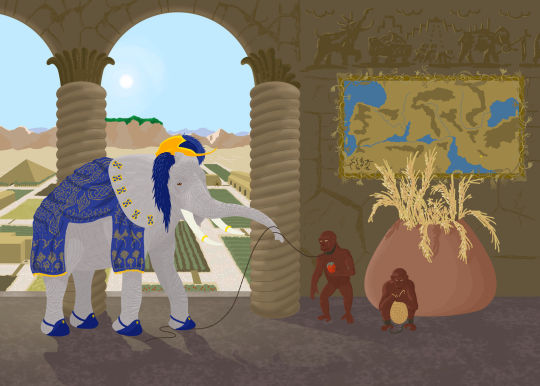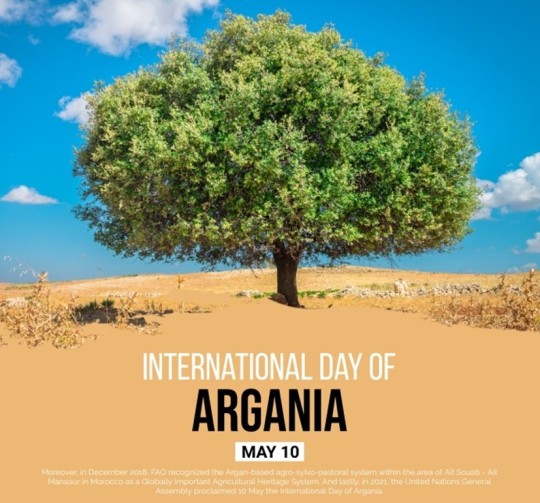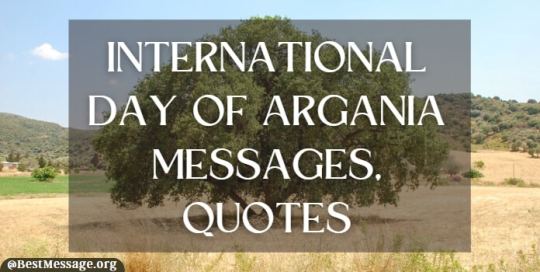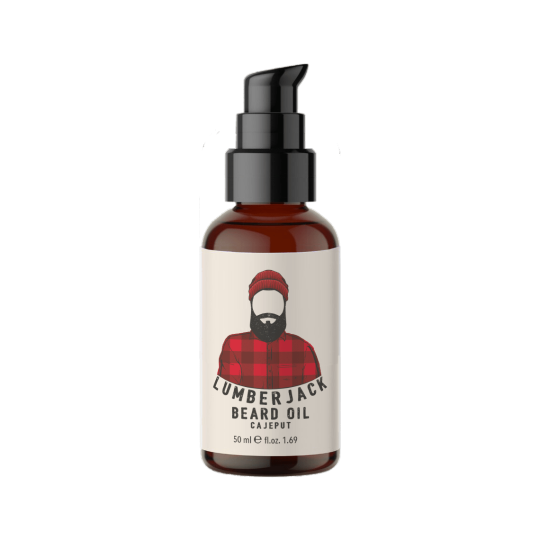#argania
Text
Socio-economic development & sustainability of the Argan ecosystem.
The United Nations will celebrate the third International Day of Argania, under the theme: "Socio-economic development & sustainability of the Argan ecosystem." The celebration will aim to share knowledge and practices from the Argan production sector, in support of food security and sustainable production and consumption patterns. Follow the event on UN Web TV on 10 May, 3:00 pm EST

#argan tree#araganeraie seeds#argan forest#argania#argania tree#argan oil#10 may#sustainable cultivation practices#sustainable development#argan ecosystem#resilient ecosystems#sdg12#Sustainable consumption#sustainable products
0 notes
Photo

[REVIEW] ARGANIA LIP FUEL (Peachy Cheeks 🍑) . My lips has been super dry every morning I wake up due to the cold, rainy weather & I came across this highly raved lip oil on TikTok that is made in Malaysia! . This ultra-nourishing lip oil is enriched with Jojoba Oil and Vitamin E which makes my lips moisturised, smooth and healthy looking 😍 . I got the peach scented version which does leave a pink tint and smells like peaches too! . I do notice that my lips are less flaky and hydrated. Just be careful not to apply too much or else it looks VERY pink on the lips 😂 Not sure if they have a non-tinted version but if they do I'll definitely get it! . Interested to try this? You can get it here: https://shope.ee/7UfS3YIwE5 . . #lipoil #lipfuel #argania #tintedlipoil #skincare #lipcare #skincarereview #madeinmalaysia (at Singapore / Singapura / 新加坡 / சிங்கப்பூர்) https://www.instagram.com/p/Cjfgb4dL5Mr/?igshid=NGJjMDIxMWI=
0 notes
Text
HSN Beauty Formula - Farmasi USA
https://farmasius.com/ua000007/product/detail/hsn-beauty-formula?pid=1000905
HSN Beauty Formula support and maintain the growth of healthy hair, skin and nails with unique combination of Zinc, Biotin, Argan Extract, Hyaluronic Acid, Type I Collagen and other valuable components.
It is also:
NON GMO
GLUTEN FREE
LACTOSE FREE
NO PRESERVATIVES
NO SWEETENER
NO ADDED COLOR
NO ADDED…

View On WordPress
#Alpha lipoic acid#Argan extract (Argania spinosa (L.) Skeels#Calcium d-pantothenate#Cholecalciferol#Choline bitartrate#D-Biotin#Dl- alpha tocopheryl acetate#Emulsifier: Magnesium stearate#FARMASI Colombia#farmasi usa#Ferrous fumarate#Green tea extract (Camellia sinensis#Herb#Horsetail extract (Equisetum arvense#hyaluronic acid#Hydrolyzed Collagen#L-Ascorbic Acid#Leaf)#Manganese sulfate#Methylcobalamin#Microcrystalline Cellulose#Nicotinamide#Para-amino benzoic acid#Pteroylmonoglutamic acid#Pyridoxine hydrochloride#Retinyl Palmitate#Ribo_avin#Seed oil)#Sodium selenite#Thiamine mononitrate
0 notes
Text
Holidays 5.10
Holidays
American Planetarium Day
Asian Pacific American Mental Health Day
AWS Smart Business Day
Bad Breath Day (UK)
Bear Witness Day (Canada)
Children’s Day (Maldives)
Clean Up Your Room Day
Confederate Memorial Day (NC, SC)
Constitution Day (Azerbaijan, Micronesia)
Dia De La Madre (Mexico)
Ependymoma Awareness Day
Fight Day (Japan)
Finger Face Puppet Day
Five & Dime Day
510 Day
Flower Festival (Azerbaijan)
German Shepherd Day
Golden Spike Day
Home Guard Day (UK)
Human Kindness Day
Indian Arrival Day (Jamaica)
International Day of Argania
International Monty Python Day
Library Legislative Days
Maid Day (Japan)
McHappy Day (Canada)
Mother Ocean Day
Mother’s Day (El Salvador, Guatemala, Mexico)
Move for Health Day
National Bonsai Day
National Brand Day (China)
National Cactus Day
National Canine Companion Graduation Day
National Child Care Provider Appreciation Day
National Clean Your Room Day
National Day of Action Against Anti-Asian Racism (Canada)
National Lipid Day
National Mangrove Day (Thailand)
National School Nurse Day
National Ship Via Rail Day
National Small Business Day
National Tree Growing Day (Kenya)
National Washington Day
Native American Day (Indiana)
Occupational Safety and Health Professional Day
One Day Without Shoes
Pastele Blajinilor (Memory/Parent’s Day; Moldova)
Resistance and Liberation Day (Lebanon)
Ring Day
Royal Ploughing Ceremony (Thailand)
Skunks Born Day
Stay Up All Night Night
Tag des Buches (Book Day; Germany)
Thrift Day (French Republic)
Tower Technician Appreciation Day
Trust Your Intuition Day
Whacking Day (The Simpsons)
Windmill Day
World Day of Social Communications
World Facilities Management Day
World Lupus Day
World Orienteering Day
Food & Drink Celebrations
National Chocolate Fish Day (New Zealand)
National Liver and Onions Day
National Shrimp Day
World Poultry Day
Independence & Related Days
Constitution Day (Micronesia)
Hashima (Declared; 2016) [unrecognized]
Romania (from Ottoman Empire, 1877)
2nd Friday in May
Child Care Provider Appreciation Day (a.k.a. Provider Appreciation Day) [Friday before Mother's Day]
Dia de la Madre (El Salvador) [2nd Friday]
Fintastic Friday: Giving Sharks A Voice [2nd Friday]
Flashback Friday [Every Friday]
Fry Day (Pastafarian; Fritism) [Every Friday]
International Professional Drivers Day [2nd Friday]
Military Spouse Day [Friday before Mother's Day]
Miniskirt Day [2nd Friday]
Mother’s Day (Guatemala; Women Employees only) [2nd Friday]
Mother’s Day (Mexico) [2nd Friday]
National Public Gardens Day [Friday before Mother's Day]
National School Communications Day [2nd Friday]
Shades Day [Friday closest to 5.15]
Working Mother’s Day [2nd Friday]
World PICU Day [2nd Friday]
Weekly Holidays beginning May 10 (1st Full Week)
National Public Gardens Week (thru 5.19) [Begins Friday before Mother’s Day]
UN Global Road Safety Week (thru 5.14)
Universal Family Week (thru 5.16)
Festivals Beginning May 10, 2024
BBQ & Barrels (Owensboro, Kentucky) [thru 5.11]
Canadian Tulip Festival (Ottawa, Canada) [thru 5.20]
Canby Brewfest (Canby, Oregon) [thru 5.11]
FedCon (Bonn, Germany) [thru 5.12]
Genuss Festival (Vienna Culinary Festival; Vienna, Austria) [thru 5.12]
Lexington Craft Beer Week (Lexington, Kentucky) [thru 5.19]
McAlester Italian Festival (McAlester, Oklahoma) [thru 5.11]
Mesick Mushroom Festival (Mesick, Michigan) [thru 5.12]
Middle Tennessee Strawberry Festival (Portland, Tennessee) [thru 5.11]
Norfolk & Norwich Festival (Norwich, UK) [thru 5.26]
Piney Woods Wine Trail Festival (Lindale, Texas) [thru 5.11]
Rochester Lilac Festival (Rochester, New York) [thru 5.19]
Shepherds Harvest Sheep and Wool Festival (Lake Elmo, Minnesota) [thru 5.12]
Smoke on the Lake BBQ Festival (Acworth, Georgia) [thru 5.11]
Texas Crab Festival (Crystal Beach, Texas) [thru 5.12]
Vintage & Vino (Queen Creek, Arizona) [thru 5.12]
The WhiskyX (Boston, Massachusetts)
Feast Days
Alphius, Philadelphus and Cyrinus (Christian; Martyrs)
Antonius, Archbishop of Florence (Christian; Saint)
Aurelian of Limoges (Christian; Saint)
Calepodius (Christian; Saint)
Catald (a.k.a. Cathal; Christian; Saint)
Comgall (Christian; Saint)
Damien of Molokai (Christian; Saint)
Desmond MacNamara (Artology)
Feast of the Wedding of Shiva & Meenakshi (India; Everyday Wicca)
Fido (Muppetism)
Galepodius (Christian; Martyr)
Gordian and Epimachus (Christian; Martyrs)
Hannibal (Positivist; Saint)
Incense to Bring Love Day (Starza Pagan Book of Days)
Job the Patriarch (Roman Catholic Church, pre-1969 calendar)
John of Ávila (Christian; Saint)
John Holmes Day (Church of the SubGenius; Saint)
Konstantinos Parthenis (Artology)
Lemuralia, Day 2 (Ancient Rome; Dedicated to Eradicating Malevolent Spirits of the Dead)
Lofn’s Blot (Pagan)
Mutant Awareness Day (Pastafarian)
Paul Wunderlich (Artology)
Rosalia (Ancient Roman Memorial Day)
Solangia (Christian; Virgin & Martyr)
Tin Hat Day (Chinese Goddess of the North Star; Hong Kong)
Wolverine Day (Pastafarian)
Lucky & Unlucky Days
Lemuria (Day 2 of 3; Ancient Rome) [Unlucky to Marry]
Shakku (赤口 Japan) [Bad luck all day, except at noon.]
Tycho Brahe Unlucky Day (Scandinavia) [22 of 37]
Premieres
Alligator Crawl, recorded by Louis Armstrong and His Hot Seven (Song; 1927)
All Things Bright and Beautiful, by James Herriot (Novel; 1975)
The Cider House Rules, by John Irving (Novel; 1985)
Cold Comfort Farm (Film; 1996)
Computer World, by Kraftwerk (Album; 1981)
Dorsai!, by Gordon R. Dickson (Novel; 1959)
Farm Frolics (WB MM Cartoon; 1941)
Feather Bluster (WB MM Cartoon; 1958)
Fish Follies (Phantasies Cartoon; 1940)
The Flowers of Buffoonery, by Osamu Dazai (Novel; 1935)
For a Few Dollars More (Film; 1967)
Gatsby (Film; 2013)
Good Omens, by Neil Gaiman and Terry Pratchett (Novel; 1990)
Guntram, by Richard Strauss (Opera; 1894)
The Hot Rock, by Donald E. Westlake (Novel; 1970)
In Dutch (Disney Cartoon; 1946)
I Shot the Sheriff, recorded by Eric Clapton (Song; 1974)
Last and First Men, by Olaf Stapledon (Novel; 1930)
Lovesexy, by Prince (Album; 1988)
The Man Who Fell to Earth, by Walter Tevis (Novel; 1963)
Misunderstanding, by Genesis (Song; 1980)
Monty Python and the Holy Grail (Film; 1975)
The Muppets Mayhem (TV Series; 2023)
Murder in the Mill-Race, by E.C.R. Lorac (Novel; 1952)
Patriotic Popeye (Fleischer/Famous Popeye Cartoon; 1957)
The Pink Panther: Pink at First Sight (DePatie-Freleng Animated TV Special; 1981)
Pokemon: Detective Pikachu (Film 2019)
Porky’s Ant (WB LT Cartoon; 1941)
The Professor and the Madman (Film; 2019)
Rabbit Transit (WB LT Cartoon; 1947)
Rio, by Duran Duran (Album; 1982)
The Silmarillion, by J.R.R. Tolkien (Novel; 1978)
Sock a Doddle Do (WB LT Cartoon; 1952)
Tolkien (Film; 2019)
Twister (Film; 1996)
Under the Counter Spy (Woody Woodpecker Cartoon; 1954)
Up the Down Staircase, by Bel Kaufman (Novel; 1964)
Weezer (a.k.a. The Blue Album), by Weezer (Album; 1994)
Today’s Name Days
Gordian, Isidor, Liliana (Austria)
Ivan, Job (Croatia)
Blažena (Czech Republic)
Gordianus (Denmark)
Aina, Aini, Ainike, Aino, Ainu (Estonia)
Aina, Aini, Ainikki, Aino (Finland)
Solange (France)
Damian, Gordian, Isidor, Liliana (Germany)
Simon, Simonas (Greece)
Ármin, Pálma (Hungary)
Alfio, Antonino, Cataldo, Miro, Quarto (Italy)
Maija, Mairita (Latvia)
Putinas, Sangailė, Viktorina (Lithuania)
Asbjørg, Asbjørn, Espen (Norway)
Antonin, Częstomir, Izydor, Jan, Symeon, Wiktoryna (Poland)
Simon (România)
Viktória (Slovakia)
Damián, Juan (Spain)
Esbjörn, Styrbjörn (Sweden)
Cormac, Cormick, Gordon, Job, Joby, Jobina, Max, Maximilian, Maximus, Maxine, Maxwell (USA)
Today is Also…
Day of Year: Day 131 of 2024; 235 days remaining in the year
ISO: Day 5 of week 19 of 2024
Celtic Tree Calendar: Saille (Willow) [Day 27 of 28]
Chinese: Month 4 (Ji-Si), Day 3 (Jia-Xu)
Chinese Year of the: Dragon 4722 (until January 29, 2025) [Wu-Chen]
Hebrew: 2 Iyar 5784
Islamic: 2 Dhu al-Qada 1445
J Cal: 11 Magenta; Foursday [11 of 30]
Julian: 27 April 2024
Moon: 8%: Waxing Crescent
Positivist: 19 Caesar (5th Month) [Paulus Aemilius]
Runic Half Month: Ing (Expansive Energy) [Day 1 of 15]
Season: Spring (Day 53 of 92)
Week: 2nd Week of May
Zodiac: Taurus (Day 21 of 31)
Calendar Changes
Ing (Expansive Energy) [Half-Month 10 of 24; Runic Half-Months] (thru 5.28)
1 note
·
View note
Text
Argan oil is a natural oil derived from the kernels of the argan tree (Argania spinosa), which is native to Morocco. It is often used for cosmetic and culinary purposes due to its purported health and beauty benefits.
2 notes
·
View notes
Photo

Gods of Salt, or the “““real””” origins of humankind
Might as well post it here directly. (original link, full text under the cut)
« Certainly Nature, when she left the making
Of animals like these, did well indeed,
By taking such executors from Mars;
And if of elephants and whales she doth not
Repent her, whosoever looketh subtly
More just and more discreet will hold her for it;
For where the argument of intellect
Is added unto evil will and power,
No rampart can the people make against it. »
– Inferno, Canto XXXI, 49-57
Consider the following facts:
#1: The Mediterranean Sea loses more water to evaporation than it receives from rivers: it only maintains its level thanks to influx from the Atlantic. Between 6.0 and 5.3 million years ago, in the late Miocene epoch, the closure of the Gibraltar Strait caused the Mediterranean to dry out. This is known as the Messinian Salinity Crisis, and it left vast deposits of gypsum and rock salt. At its apex, this event would have reduced the sea to a few puddles of hypersaline water, similar to today's Dead Sea, surrounded by scorching desert - with temperatures possibly reaching over 40°C due to high pressure. Its islands and peninsulas would have turned to massive mountain ranges up to 5 km tall ([1]). This event ended with the so-called Zanclean Flood, when the Atlantic waters rushed back into the basin, through not one but a series of waterfalls. The overall drop was more than a km, and the discharge of water has been estimated at a thousand time that of the Amazon River ([2]). That's enough to refill the whole Mediterranean in less than 20 years. A sumberged barrier, known as Camarinal Sill, forms the shallowest part of the strait, at only 280 meters below sea level ([3]).
#2: Nevertheless, despite its terrible conditions, the Mediterranean Basin still had enough hospitable land to allow animals to move from Africa to Europe, and vice versa. In fact, the climate, flora, and fauna of Africa and Europe were very similar in the Miocene. Dwarf species of hippopotami and elephants have been found in Cyprus, Crete, Malta, Sicily, Sardinia, the Balearics: all the main islands of the Mediterranean. The lowland-dwellers could have lived along rivers like Po, Rhone, and Nile, which would have cut much deeper valleys.
#3: The Miocene was also a time of great diversity of mammals. In particular, it was the golden age of elephants (which existed in every continent but Australia) and apes (which were even abundant in Europe). European apes included the swamp-dwelling Italian Oreopithecus, 9-7 million years old, which had a pelvis suited for an almost bipedal locomotion ([4]), and hands more capable of precision gripping than those of any living non-human ape ([5]). As for elephants, Primelephas, the likely common ancestor of mammoths and all living elephants, lived in Africa at the end of the Miocene.
#4: Molecular studies place the separation between the lineages of humans and chimpanzees between 7 and 5 million years ago, later than Oreopithecus, and corresponding with the Messinian event. Recent estimates push the divergence backward, even to 10-12 million years ago; however, controversial studies suggest that the two lineages exchanged genes as recently as 4 million years ago ([6]). Clearly the process of separation was more complex than we realized at first, and involved some degree of hybridization between the recent lineages.
#5: The Mediterranean region contains a vast diversity of halophytes, plants than can grow despite high concentrations of salt. Many of these are suitable for human consumption: the oil-rich salicornia (Salicornia sp., eaten both fresh and pickled), the cabbage-like sea kale (Crambe maritima, which grows spontaneously on sandy beaches), the spinach-like sea orach (Atriplex halimus, a close relative of which is grown in India as vegetable and livestock fodder). The argan tree (Argania spinosa) is extremely resistant to both salt and drought, and is prized in Europe and North Africa for its wood and oil. ([7])
#6: The list of Mediterranean halophyte species is actually much wider, but many plants that grow in these conditions are not useful to humans: for example, the Mediterranean beard-grass (Polypogon maritimus), a close relative of oat and wheat, much less nutritious than either. Note, however, that elephants (much more common and diverse in this region in the Miocene) have very low nutritional requirements, and can feed on almost any type of vegetable matter. Now, a key characteristic of the Miocene epoch is a wide spreading of grasslands, replacing the forests that earlier covered most of the globe, triggering a wave of adaptation and diversification among mammals. In fact, between 10 and 5 million years ago, the diet of elephants has switched from leaves to tall grass, a change that can be seen in the shape of their teeth ([8]). Only in the last million years elephants have reverted to eating leaves ([9]).
#7: Until recently, the divergence between humans and chimpanzees had been linked to this event: the ancestors of chimpanzees would have remained in the thick rainforests of West Africa, while humans evolved in the new savannas of the east. This places human evolution entirely in eastern and southern Africa until the last million years or so. This view has been challenged by recent finds. In 2002, the 7-6 million years-old Sahelanthropus tchadensis, a serious contender as common ancestor of humans and chimpanzees, was discovered in Chad, in North Africa. Its foramen magnum suggests an already bipedal pace, as with Oreopithecus ([10]). In 2017, curiously human-like teeth, 7.2 million years old, were attributed to Graecopithecus, in Greece ([11]). Finally, in the same year, 5.6 million years old footprints that clearly show bipedal locomotion were found in Crete ([12]). All of this suggests that the earliest human evolution occurred at first in the Mediterranean region.
#8: The intelligence of elephants is well known. Their brain, over 5 kg heavy, has more cortical gyres than any primate or cetacean, and they might rank in intelligence besides chimps and dolphins ([13]). They form matriarchal herds with extremely strong interindividual bonds and great capacity for cooperation and reciprocal help. They are the only known non-human animals that seem to have ritual behavior related to death ([14]). Pregnant elephants have been observed chewing on leaves of a Boraginacean tree, used to induce labor or miscarriage by Kenyan women ([15]). They can use branches as simple tools, cover water pools to prevent evaporation, and use logs to disable electric fences ([16]). They can recognize themselves in the mirror ([17]), and seem to have artistic inclinations ([18]). Such abilities are especially astonishing in view of such an energy-poor diet. Yet we have seen that their diet was very different in the latest Miocene - that there are plants that grow in the Mediterranean region, could be eaten by ancient elephants, increased in diversity at that time, and are closely related to our food crops.
#9: The elephants' trunk is a dexterous organ of manipulation, capable of handling single seeds and inspecting delicate bodyparts like eyes. Nevertheless, having only one grasping organ could be a handicap for an active tool user (the two fingerlike tips are unique to the African species, and probably didn't exist in Miocene elephants). The trunk can lift loads of hundreds of kilograms, but it's poor at grasping large objects, and can only wrap around them. In comparison, the hands of apes are much more versatile, especially after the innovation we have seen in Oreopithecus. In addition, the same amount of food that sustains an elephant with its single trunk can support not two, but several ape hands - especially since high-energy primate food can pack nourishment in a much smaller mass, even when inedible to elephants.
#10: African elephants in reserves readily initiate contact with humans, often forming long-lasting individual bonds, and often prefer to interact with humans than with other animals of their environment. Many of these elephants appear more relaxed and at ease near humans than near even other elephants. This effect has been documented in species with a long history of domestication by humans, such as dogs and horses. ([19]).
Let's place everything together. Six million years ago, near the end of the Miocene epoch, the natural closure of the Gibraltar Strait turned the Mediterranean Sea into a salty desert. The few inhabitable spaces provided a safe passage between Africa and Europe for many species; elephants and apes, which had been increasing in diversity for all the Miocene, were among them.
The depths of the new Mediterranean basin, on the other hand, were a hellish environment that must have forced many species into desperate adaptations. Many plants learned to grow in sand, long before the Sahara became a desert, with concentrations of salt that would kill most others. Elephants, we've seen, are good at finding and storing water, using tools to prevent evaporation from reserves. They must have evolved their characteristic intelligence to deal with the unique challenges of the Mediterranean Basin. Like the Khoisan hunter-gatherers of the Kalahari desert (or for that matter the earliest Homo sapiens) they needed advanced problem-solving skill, good memory, and the ability to cooperate and trust each other.
Their eventual solution to ensure themselves a food supply in the great basin was agriculture. Many Mediterranean halophytes are edible even in the seed- and fruit-focused human diet; but the sapient elephants of the Miocene could feed even on simple grass. Cereals like Polypogon - which are, after all, nothing more than especially nutritious grass - must have been a blessing. Perhaps they were even selected artificially to tolerate more saline soils, as could have been the precious argan tree.
Still, the burgeoning elephantine civilization was slowed down by their sluggish reproduction and by their limited capacity for manipulation. The trunk was very effective, but every elephant could only hold one thing at a time. They must have experimented with many forms of animal labor (as well as hydraulic, etc.), but none of the many animals of their region could help them handle objects, make cheap craftwork, or operate machines.
Eventually, they started working with apes. Maybe they took a sample of Oreopithecus descendants or Graecopithecus from the northern highlands. They were clever animals, forged by the same cruel environment, capable of understanding gestures and executing simple orders. They wouldn't take away the hard leaves and grass of their masters, but they would eat almost anything else (to the elephants, the ability to digest meat must have seemed extremely precious). They had hands: two hands to grasp a broad object without handles, to scatter seeds on a field, or to hold hammer and chisel in the making of a triumphal arch.
So the elephants found themselves ruling over a vast caste of small, nimble, infinitely versatile slaves. Surely they must have tried to enhance them through selective breeding, as humans did with dogs and horses, creating features similar to the short jaws and small teeth of humans, or the peaceful countenance of bonobos. Their genes still bear traces of closely related lineages being interbred. They certainly encouraged a bipedal gait, so that the precious hands remained always free. With ape-servants so common and useful, crawling all around like living robots, elephants must have had little incentive to improve their technology further.
Remember the air at the bottom of the Basin was very thick: it's likely the elephants were specially adapted to breathe it, and would feel much discomfort outside of their cradle. They never ventured beyond what today is the coastline of the Mediterranean, which must have looked like impassable mountains to them. However, they could have sent their servants in exploration on the great islands: leaving, for example, the mysterious footprints of Crete.
The proboscidean rulers probably didn't have much more concern for their primate slaves than humans have for cows in a slaughterhouse. Even though they couldn't eat them, they could still fashion their skins and bones into precious objects; sacrifice them to elephantine gods atop of a ziggurat raised by their work; make them fight in blood games or proxy battles; use them for carnal gratification or for medical experiments. The different proclivities of humans, bonobos, and chimpanzees can be understood as specialization for such tasks. We can only wonder what the apes could understand of their condition.
The civilization of elephants had 600,000 years to develop between the Messinian Crisis and the Zanclean Flood: thrice the age of our own species. Certainly they studied in depth their secluded world. As the sea level started to increase on the Gibraltar Strait, they would have probably predicted the danger, and built a massive dam to block the way of the Atlantic waters. Maintaining this dam must have been the highest priority. But there were certainly those who didn't believe this looming danger. And in the end the central sin of the elephantine empire must have caught up to them.
What could have distracted the elephants from preserving the Mediterranean Basin as they found it? Probably action from those who had nothing to lose from utter destruction - such as ape-slaves who had finally crossed the threshold of self-awareness. Or rather a preemptive action from those who feared a revolt more than their own annihilation? Some kind of sabotage action, perhaps, that ended a millennia-spanning history by breaking down the great dam, letting the ocean pour into the Basin with an unimaginable catastrophe, and turn it back into a sea.
Some survived, both apes and elephants. They must have been few, perhaps outcasts that had fled, or had been exiled, to the outer highlands. Gradually they accustomed themselves again to the thin air (maybe this didn't even require evolutionary adaptation, just individual assuefaction; but the lords below were used to comfort...). Some were stranded on the new islands, and became the dwarfs of Cyprus, Crete, Sicily. The others scattered into the wilderness of Africa and Europe.
Without the infrastructures of the submerged empire, unprepared for the different environment outside, they were unable to rebuilt their civilization. Most of them had been poorly inserted in society, and their intellective faculties weren't the highest, either as a cause or a consequence of their isolation. Alone, they reverted to wild animals, and became gentler than they ever had been when they were civilized beings. They still retain the vestigial skills of artists and doctors; they still mourn the death of their kin.
The surviving apes, now free, wandered back into the heart of Africa, passing through Chad. Some found shelter in the jungles of Congo and Nigeria, others in the savannas of Kenya and South Africa, that perhaps reminded them of the flat lands where they were bred into their new shape.
Five million years after that unimaginable disaster, silt has covered all the ruins on the Mediterranean seafloor, and the "domesticated apes" have left Africa in three waves of migration. Now they control the world, from coastlines to mountains, they remake its land into cities and farms, and they hold in their power the fate of the distant descendants of their ancient masters.
It remains to be seen whether they will choose to be merciful or vindictive. Aren't five million years enough to expiate any sin?
40 notes
·
View notes
Text
Best Lineup Spray: Achieve a Perfect Hairline Every Time
Best Lineup Spray
Best Lineup Spray: Achieve a Perfect Hairline Every Time
Introduction
When it comes to grooming, maintaining a sharp hairline is a top priority for many men. However, achieving a clean and precise hairline can be a challenge, especially for those with curly or unruly hair. Luckily, there is a solution: the Best Lineup Spray.
Key Ingredients in the Best Lineup Spray
Argania…

View On WordPress
2 notes
·
View notes
Text
Dormi Veil Body makeup Foundation

For Face & Body
Dormi Veil face & body foundation is a must-have for all your face and body makeup needs! It gives you a beautiful, illuminated look with a smooth, hydrated glow that won’t streak or look harsh. Its waterproof and long-lasting formula is packed with SPF protection for your skin. Use it on its own for beach days, night outs, and more. veil body foundation is transfer-proof, smudge-proof, and best of all, it won’t clog your pores!
Dormi Body Foundation is perfect for concealing scars, stretch marks, and other skin imperfections. It is formulated to glide on smoothly and provide full coverage with a natural, matte finish. Veil offers an array of shades to suit all skin tones. Get ready to get the best!
This Quick-drying, skin-like, transfer-proof, water-proof, smudge-proof formula, provides the skin with an even and natural appearance, allowing you to use it anywhere at any time.
Dormi Veil face & body foundation is a must-have for all your face and body makeup needs! It gives you a beautiful, illuminated look with a smooth, hydrated glow that won’t streak or look harsh. Its waterproof and long-lasting formula is packed with SPF protection for your skin. Use it on its own for beach days, night outs, and more. veil body foundation is transfer-proof, smudge-proof, and best of all, it won’t clog your pores!
The Veil foundation for the face & body has a velvet matt finish to reveal the most comfortable, perfect-finish appearance to it.
INNOVATION
The formulation is enriched with Vitamin E and Shea Butter, delivering a richly moisturizing and nourishing experience to the skin. The combination of Smart Pigments and HD Pixel Precision creates a perfecting veil that softly absorbs facial imperfections. The result is a complexion that looks healthy, natural, and radiant, it’s the perfect body foundation.
Veil Foundation Ingredients:
INGREDIENTS
ISOBUTANE, HYDROFLUOROCARBON 152A, PROPANE, WATER (AQUA), ISODODECANE, SYNTHETIC SAPPHIRE, SHEA BUTTER, SUNFLOWERSEED OIL , ARGANIA SPINOSA KERNEL OIL, SPENT GRAIN WAX (HORDEUM VULGARE CERA), , ACETYL HEXAPEPTIDE-1, DIATOMACEOUS EARTH, GLYCERIN,TOCOPHEROL, SYNTHETIC FLUORPHLOGOPITE, AMMONIUM ACRYLATES COPOLYMER, DIMETHICONE, DIMETHICONOL, BUTYLENE GLYCOL, DISTEARDIMONIUM HECTORITE, CETYL PEG/PPG-10/1 DIMETHICONE, SORBITAN OLEATE, PEG-10 DIMETHICONE, GLYCERYL CAPRYLATE, PROPYLENE CARBONATE, FRAGRANCE (PARFUM), VA/BUTYL MALEATE/ISOBORNYL ACRYLATE COPOLYMER, ,, SODIUM LEVULINATE, SODIUM ANISATE, ZINC SULFATE, LAUROYL LYSINE, TIN OXIDE [MAY CONTAIN (+/-): TITANIUM DIOXIDE (CI 77891), IRON OXIDES (CI 77492, CI 77491, CI 77499)]
Directions of use :
Shake liquid well.
Clean and dry the area you wish to spray before application.
Apply using a continuous motion.
Let the product dry for 1-2 minutes and use your hand to check that Dormi has dried to form a perfecting veil over your skin.
To remove: please use makeup remover.
IMMEDIATE RESULTS
Improves skin texture and clarity.
Fades existing dark spots and prevents new ones from forming.
Reduces the appearance of wrinkles, fine lines, and scars.
Strengthens skin’s natural defense system against environmental stressors.
Minimizes breakouts and acne-related scars.
How to choose the shade?
It is always recommended to choose the closest foundation color that matches your skin tone in order to look natural and blend well into your skin without looking weird or fake.
The veil body foundation has 7 universal shades. You can always choose 2 shades and mix and match both if you feel like your skin tone is between two shades of our product, also having 2 shades, you will be able to match your skin color all year long if you get tanned in the summer for example so it’s a plus!
#beauty#beauty products#skin care products#skincare#cosmetics#makeup products#makeup#women outdoors#woman#outdoors
2 notes
·
View notes
Text
Holidays 5.10
Holidays
American Planetarium Day
Asian Pacific American Mental Health Day
AWS Smart Business Day
Bad Breath Day (UK)
Bear Witness Day (Canada)
Children’s Day (Maldives)
Clean Up Your Room Day
Confederate Memorial Day (NC, SC)
Constitution Day (Azerbaijan, Micronesia)
Dia De La Madre (Mexico)
Ependymoma Awareness Day
Fight Day (Japan)
Finger Face Puppet Day
Five & Dime Day
510 Day
Flower Festival (Azerbaijan)
German Shepherd Day
Golden Spike Day
Home Guard Day (UK)
Human Kindness Day
Indian Arrival Day (Jamaica)
International Day of Argania
International Monty Python Day
Library Legislative Days
Maid Day (Japan)
McHappy Day (Canada)
Mother Ocean Day
Mother’s Day (El Salvador, Guatemala, Mexico)
Move for Health Day
National Bonsai Day
National Brand Day (China)
National Cactus Day
National Canine Companion Graduation Day
National Child Care Provider Appreciation Day
National Clean Your Room Day
National Day of Action Against Anti-Asian Racism (Canada)
National Lipid Day
National Mangrove Day (Thailand)
National School Nurse Day
National Ship Via Rail Day
National Small Business Day
National Tree Growing Day (Kenya)
National Washington Day
Native American Day (Indiana)
Occupational Safety and Health Professional Day
One Day Without Shoes
Pastele Blajinilor (Memory/Parent’s Day; Moldova)
Resistance and Liberation Day (Lebanon)
Ring Day
Royal Ploughing Ceremony (Thailand)
Skunks Born Day
Stay Up All Night Night
Tag des Buches (Book Day; Germany)
Thrift Day (French Republic)
Tower Technician Appreciation Day
Trust Your Intuition Day
Whacking Day (The Simpsons)
Windmill Day
World Day of Social Communications
World Facilities Management Day
World Lupus Day
World Orienteering Day
Food & Drink Celebrations
National Chocolate Fish Day (New Zealand)
National Liver and Onions Day
National Shrimp Day
World Poultry Day
Independence & Related Days
Constitution Day (Micronesia)
Hashima (Declared; 2016) [unrecognized]
Romania (from Ottoman Empire, 1877)
2nd Friday in May
Child Care Provider Appreciation Day (a.k.a. Provider Appreciation Day) [Friday before Mother's Day]
Dia de la Madre (El Salvador) [2nd Friday]
Fintastic Friday: Giving Sharks A Voice [2nd Friday]
Flashback Friday [Every Friday]
Fry Day (Pastafarian; Fritism) [Every Friday]
International Professional Drivers Day [2nd Friday]
Military Spouse Day [Friday before Mother's Day]
Miniskirt Day [2nd Friday]
Mother’s Day (Guatemala; Women Employees only) [2nd Friday]
Mother’s Day (Mexico) [2nd Friday]
National Public Gardens Day [Friday before Mother's Day]
National School Communications Day [2nd Friday]
Shades Day [Friday closest to 5.15]
Working Mother’s Day [2nd Friday]
World PICU Day [2nd Friday]
Weekly Holidays beginning May 10 (1st Full Week)
National Public Gardens Week (thru 5.19) [Begins Friday before Mother’s Day]
UN Global Road Safety Week (thru 5.14)
Universal Family Week (thru 5.16)
Festivals Beginning May 10, 2024
BBQ & Barrels (Owensboro, Kentucky) [thru 5.11]
Canadian Tulip Festival (Ottawa, Canada) [thru 5.20]
Canby Brewfest (Canby, Oregon) [thru 5.11]
FedCon (Bonn, Germany) [thru 5.12]
Genuss Festival (Vienna Culinary Festival; Vienna, Austria) [thru 5.12]
Lexington Craft Beer Week (Lexington, Kentucky) [thru 5.19]
McAlester Italian Festival (McAlester, Oklahoma) [thru 5.11]
Mesick Mushroom Festival (Mesick, Michigan) [thru 5.12]
Middle Tennessee Strawberry Festival (Portland, Tennessee) [thru 5.11]
Norfolk & Norwich Festival (Norwich, UK) [thru 5.26]
Piney Woods Wine Trail Festival (Lindale, Texas) [thru 5.11]
Rochester Lilac Festival (Rochester, New York) [thru 5.19]
Shepherds Harvest Sheep and Wool Festival (Lake Elmo, Minnesota) [thru 5.12]
Smoke on the Lake BBQ Festival (Acworth, Georgia) [thru 5.11]
Texas Crab Festival (Crystal Beach, Texas) [thru 5.12]
Vintage & Vino (Queen Creek, Arizona) [thru 5.12]
The WhiskyX (Boston, Massachusetts)
Feast Days
Alphius, Philadelphus and Cyrinus (Christian; Martyrs)
Antonius, Archbishop of Florence (Christian; Saint)
Aurelian of Limoges (Christian; Saint)
Calepodius (Christian; Saint)
Catald (a.k.a. Cathal; Christian; Saint)
Comgall (Christian; Saint)
Damien of Molokai (Christian; Saint)
Desmond MacNamara (Artology)
Feast of the Wedding of Shiva & Meenakshi (India; Everyday Wicca)
Fido (Muppetism)
Galepodius (Christian; Martyr)
Gordian and Epimachus (Christian; Martyrs)
Hannibal (Positivist; Saint)
Incense to Bring Love Day (Starza Pagan Book of Days)
Job the Patriarch (Roman Catholic Church, pre-1969 calendar)
John of Ávila (Christian; Saint)
John Holmes Day (Church of the SubGenius; Saint)
Konstantinos Parthenis (Artology)
Lemuralia, Day 2 (Ancient Rome; Dedicated to Eradicating Malevolent Spirits of the Dead)
Lofn’s Blot (Pagan)
Mutant Awareness Day (Pastafarian)
Paul Wunderlich (Artology)
Rosalia (Ancient Roman Memorial Day)
Solangia (Christian; Virgin & Martyr)
Tin Hat Day (Chinese Goddess of the North Star; Hong Kong)
Wolverine Day (Pastafarian)
Lucky & Unlucky Days
Lemuria (Day 2 of 3; Ancient Rome) [Unlucky to Marry]
Shakku (赤口 Japan) [Bad luck all day, except at noon.]
Tycho Brahe Unlucky Day (Scandinavia) [22 of 37]
Premieres
Alligator Crawl, recorded by Louis Armstrong and His Hot Seven (Song; 1927)
All Things Bright and Beautiful, by James Herriot (Novel; 1975)
The Cider House Rules, by John Irving (Novel; 1985)
Cold Comfort Farm (Film; 1996)
Computer World, by Kraftwerk (Album; 1981)
Dorsai!, by Gordon R. Dickson (Novel; 1959)
Farm Frolics (WB MM Cartoon; 1941)
Feather Bluster (WB MM Cartoon; 1958)
Fish Follies (Phantasies Cartoon; 1940)
The Flowers of Buffoonery, by Osamu Dazai (Novel; 1935)
For a Few Dollars More (Film; 1967)
Gatsby (Film; 2013)
Good Omens, by Neil Gaiman and Terry Pratchett (Novel; 1990)
Guntram, by Richard Strauss (Opera; 1894)
The Hot Rock, by Donald E. Westlake (Novel; 1970)
In Dutch (Disney Cartoon; 1946)
I Shot the Sheriff, recorded by Eric Clapton (Song; 1974)
Last and First Men, by Olaf Stapledon (Novel; 1930)
Lovesexy, by Prince (Album; 1988)
The Man Who Fell to Earth, by Walter Tevis (Novel; 1963)
Misunderstanding, by Genesis (Song; 1980)
Monty Python and the Holy Grail (Film; 1975)
The Muppets Mayhem (TV Series; 2023)
Murder in the Mill-Race, by E.C.R. Lorac (Novel; 1952)
Patriotic Popeye (Fleischer/Famous Popeye Cartoon; 1957)
The Pink Panther: Pink at First Sight (DePatie-Freleng Animated TV Special; 1981)
Pokemon: Detective Pikachu (Film 2019)
Porky’s Ant (WB LT Cartoon; 1941)
The Professor and the Madman (Film; 2019)
Rabbit Transit (WB LT Cartoon; 1947)
Rio, by Duran Duran (Album; 1982)
The Silmarillion, by J.R.R. Tolkien (Novel; 1978)
Sock a Doddle Do (WB LT Cartoon; 1952)
Tolkien (Film; 2019)
Twister (Film; 1996)
Under the Counter Spy (Woody Woodpecker Cartoon; 1954)
Up the Down Staircase, by Bel Kaufman (Novel; 1964)
Weezer (a.k.a. The Blue Album), by Weezer (Album; 1994)
Today’s Name Days
Gordian, Isidor, Liliana (Austria)
Ivan, Job (Croatia)
Blažena (Czech Republic)
Gordianus (Denmark)
Aina, Aini, Ainike, Aino, Ainu (Estonia)
Aina, Aini, Ainikki, Aino (Finland)
Solange (France)
Damian, Gordian, Isidor, Liliana (Germany)
Simon, Simonas (Greece)
Ármin, Pálma (Hungary)
Alfio, Antonino, Cataldo, Miro, Quarto (Italy)
Maija, Mairita (Latvia)
Putinas, Sangailė, Viktorina (Lithuania)
Asbjørg, Asbjørn, Espen (Norway)
Antonin, Częstomir, Izydor, Jan, Symeon, Wiktoryna (Poland)
Simon (România)
Viktória (Slovakia)
Damián, Juan (Spain)
Esbjörn, Styrbjörn (Sweden)
Cormac, Cormick, Gordon, Job, Joby, Jobina, Max, Maximilian, Maximus, Maxine, Maxwell (USA)
Today is Also…
Day of Year: Day 131 of 2024; 235 days remaining in the year
ISO: Day 5 of week 19 of 2024
Celtic Tree Calendar: Saille (Willow) [Day 27 of 28]
Chinese: Month 4 (Ji-Si), Day 3 (Jia-Xu)
Chinese Year of the: Dragon 4722 (until January 29, 2025) [Wu-Chen]
Hebrew: 2 Iyar 5784
Islamic: 2 Dhu al-Qada 1445
J Cal: 11 Magenta; Foursday [11 of 30]
Julian: 27 April 2024
Moon: 8%: Waxing Crescent
Positivist: 19 Caesar (5th Month) [Paulus Aemilius]
Runic Half Month: Ing (Expansive Energy) [Day 1 of 15]
Season: Spring (Day 53 of 92)
Week: 2nd Week of May
Zodiac: Taurus (Day 21 of 31)
Calendar Changes
Ing (Expansive Energy) [Half-Month 10 of 24; Runic Half-Months] (thru 5.28)
1 note
·
View note
Text

INTERNATIONAL DAY OF ARGANIA - 10 MAY 2024 - அர்கானியா சர்வதேச தினம் - 10 மே 2024.
0 notes
Text
International Day of Argania Messages and Wishes

Celebrate this day by sharing with everyone International Day of Argania messages and wishes. The occasion calls for sharing with everyone International Day of Argania quotes, sayings and greetings on Facebook, WhatsApp and Instagram.
0 notes
Text
How argan oil is made?

Follow the step-by-step process of how argan oil is made.
Did you know?
The argan tree withstands temperatures of up to 50° Celsius.
The argan trees are a true bastion against desertification, which can reach 10 meters in height and can live for 200 years.
A symbol of eternity and resistance, the argan tree has a strong symbolic and emotional value for local communities.
Argan oil is given as a wedding gift and is used extensively in the preparation of festive dishes.
It takes about 150 kg of fruit to produce 3 litres of argan oil.
#argan oil#argania#araganeraie seeds#culinary and cosmetic industries#edible leaves#edible fruits#argania tree#argan tree#rural women#step-by-step process
0 notes
Text

Hydra Groomer’s Flash Active Deep Conditioner For Pets
Hydra’s Flash Thermo conditioner is formulated for professional use on dogs and cats for quick hydration of the coat. Increases the elasticity of the coat and contains collagen to reduce frizz. A blend of Coconut, Argan, and Sesame oils, incorporated with Vitamin E, deeply moisturizes, hydrates, and restructures the skin and coat. The thermo-protective ingredients form a film on the coat, protecting it from damage caused by heat, even when wet. This is a professional product designed by groomers for groomers and is suitable for all breeds of dogs and cats where rapid hydration is required
Features:
Contains actives that moisturize the coat, leaving it soft and shiny
Added Thermo-protective action
Argan Oil: moisturizing and restructuring action
Sesame Oil: moisturizing action
Collagen: conditioning action and reducing of frizz
Coconut oil: emollient action
Suitable for dogs and cats of all breeds
Benefits:
It Promotes soft and sleek coat finishing
The thermos-protective action formula prevents heat damage caused by dryers and flat-iron.
The goodness of coconut oil & Kernel oil repairs the damaged hair and moisturizes the dry hair.
Kernel oil also helps to strengthen the hair and improves hair shine.
Specifications:
Professional–grade shampoo designed for professional quality results
Infused with Salon–Grade Ingredients for a luxurious grooming experience for Pets and professional
Ingredients:
Water, Glycerin, Cetyl alcohol, Cetearyl Alcohol, Behetrimonium Chloride, Panthenyl Hydroxypropyl Steardimonium Chloride, Quaternium 80, Collagen, Sesamum indicum(sesame) Seed Oil, Coconut Oil, Argania spinosa Kernel Oil, CI 20285, CI 19140, CI 15985, Ethylhexylglycerin, Phenoxyethanol, and Fragrance
Directions:
Bathe the animal with Hydra Shampoo Odour Neutralizing and rinse
Repeat the process with the most suitable Hydra Shampoo
Apply Thermo Active Conditioner on the coat, massaging
well. Leave on for 90 seconds and rinse well
0 notes
Text
Essence of Argan Reviews - How To Use Essence of Argan Oil And Does It Really Work?

Dive into the world of Essence Of Argan Oil and explore its transformative potential for skincare, haircare, and overall well-being. This review provides valuable insights into the effectiveness and benefits of Essence Of Argan Oil.
Curious about the transformative powers of Essence Of Argan Oil? This detailed review delves into the myriad benefits of this natural wonder for skincare, haircare, and more.
Introduction: Exploring the Miracle of Essence Of Argan Oil
In a world inundated with beauty products promising miraculous results, Essence Of Argan Oil stands out as a timeless and versatile solution for skincare and haircare needs. Derived from the kernels of the argan tree native to Morocco, this golden elixir has been revered for centuries for its nourishing and rejuvenating properties. But does it truly live up to the hype? Let's embark on a journey to uncover the wonders of Essence Of Argan Oil and discover how it can elevate your beauty routine to new heights.
The Origins of Essence Of Argan Oil: A Natural Wonder
Essence Of Argan Oil originates from the argan tree, scientifically known as Argania spinosa, which thrives in the arid regions of Morocco. For generations, the Berber women of Morocco have harvested the precious kernels from the argan tree and extracted the oil using traditional methods passed down through centuries. Today, Essence Of Argan Oil continues this legacy of sustainability and tradition, sourcing only the finest argan kernels to create a premium-grade oil that encapsulates the essence of natural beauty...
Full Essence Of Argan Reviews here! at https://scamorno.com/Essence-Of-Argan-Reviews-Oil/?id=tumblr-howtouse
The Benefits of Essence Of Argan Oil: Unlocking Nature's Secrets
Skincare Marvel: Essence Of Argan Oil is a powerhouse of hydration, penetrating deeply into the skin to moisturize and nourish from within. Its antioxidant-rich formula helps combat free radicals, reducing the signs of aging and leaving skin radiant and youthful.
Haircare Essential: Say goodbye to dry, brittle hair with Essence Of Argan Oil. This lightweight oil absorbs quickly into the hair shaft, restoring moisture and shine without weighing hair down. It also helps tame frizz and flyaways, leaving hair silky smooth and manageable.
Versatile Wonder: From soothing dry cuticles to softening rough elbows, Essence Of Argan Oil is a multi-tasking marvel. Its natural emollient properties make it ideal for addressing a myriad of skincare concerns, including eczema, psoriasis, and acne.
FAQs (Frequently Asked Questions) About Essence Of Argan Oil
1. Is Essence Of Argan Oil suitable for all skin types? Yes, Essence Of Argan Oil is gentle and suitable for all skin types, including sensitive skin.
2. How often should Essence Of Argan Oil be applied? For best results, Essence Of Argan Oil can be applied daily, both morning and evening, to clean, dry skin or hair.
3. Can Essence Of Argan Oil be used on the face? Yes, Essence Of Argan Oil is non-comedogenic and can be used on the face to moisturize and nourish the skin.
4. Is Essence Of Argan Oil cruelty-free and vegan? Yes, Essence Of Argan Oil is cruelty-free and vegan, containing no animal-derived ingredients and not tested on animals...
Full Essence Of Argan Reviews here! at https://scamorno.com/Essence-Of-Argan-Reviews-Oil/?id=tumblr-howtouse
1 note
·
View note
Text
"Natural Argan oil is extracted from the kernels of the Argania Spinosa tree native to Morocco. Renowned for its nourishing properties, this oil is rich in antioxidants, fatty acids, and vitamins. It's prized for its ability to moisturize skin, condition hair, and promote overall wellness."

Natural Argan oil is extracted from the kernels of the Argania Spinosa tree found Only in Morocco, it's cold-harvested in a way that makes it preserve all of it's components.
Components List:
Omega-6 linoleic acid: Perfect for highly-porous hair replenish and reinforce the skin's lipid barrier
Omega-9 oleic acid: Ideal for medium porosity hair.
Phytosterols: Moisturize, tighten skin, have antiseptic effect.
Flavonoids: Strong antioxidants, soothe inflammation, have a strong Anti Aging effect.
Carotenes: Stimulate collagen production, normalize excessive sebum secretion.
Squalane: Moisturizes, enhances condition of hair and skin.
Butyrospermol: UV filter, protects skin & hair against the sun damage.
Vitamin E: A Strong antioxidant, Heals Skin, slows down aging process.
0 notes
Text
Lumberjack Beard Oil - Cajeput
Modo d’uso:
Applicare alcune gocce 1-2 volte al giorno massaggiando con cura la barba.
Non necessita di risciacquo.
Ingredienti:
Cyclopentasiloxane, Dimethiconol, Melaleuca leucadendron Cajaputi Oil, Helianthus annuus Seed Oil, Juglans regia Shell Extract, Simmondsia chinensis Seed Oil, Argania spinosa Kernel Oil, Macadamia ternifolia Seed Oil, Limonene, Linalool, Capsanthin/Capsorubin, Zea mays…

View On WordPress
0 notes